I’ve done these annual reviews of my health/fitness/longevity journey every year going back to 2017. Every year it is the same lament about how off track I was most of the year. Last year was the first year where I had the better part of a year in a solidly performing zone. This year is the first one where I had an entire year in the solidly performing zone, having extended the fitness reboot I started in April of 2023 all the way through to the end of 2024. A perfect performance? Absolutely not. But perfect is the enemy of good enough, and I’m celebrating the win for what it is: a solid step towards improving the odds of having a good long healthspan. Not only that I started the year saying I was hoping to maybe run a half marathon strongly. Instead by the end of the year I ran two half marathons strongly, not counting training runs of equal or longer distances, and ran a marathon with a pretty solid performance as well.
Goal Accountability
I was coming of a very strong second half of the year when I set my goals for 2024. They had stayed pretty consistent for quite some time. I allow myself to re-evaluate and tweak them each month but I wasn’t expecting dramatic changes. Indeed, the changes were tweaks. I started off with the criteria for my five longevity goals being:
- Goal 1 (Diet): Eat a plant dominant Mediterranean diet averaging at least 90 grams of protein a day
- Goal 2 (Sleep): Get 7-8 hours of sleep a night
- Goal 3 (Cardio Health): 30 minutes of focused cardio exercise (indoor cycling, running, swimming, etc), with one hard session per week minimum and a stretch goal of two hard sessions per week
- Goal 4 (Non-Cardio Health): 20-30 minutes of weight training, calisthenics, or yoga
- Goal 5 (Brain Health): 15-20 minutes of meditation or alternative learning, stretch goal of 15-20 minutes of meditation and alternative learning or a second meditation session.
This held up for several months. Then, in April I completed one of the stretch goals I was eager to attempt on January 1st of last year: complete a half marathon strong. I wrote about that in other running specific posts. The achievement was great but I wanted to get more focused training. I wanted to try to hit even more ambitious running goals like completing a marathon strong before the end of 2025. I was trying to get faster and add distance while not sacrificing any of my longevity goals by overtraining, creating repetitive stress issues in joints, etc. There were too many contradicting conventional wisdoms for me to fix all that on my own. So in May, after my half marathon and after recovering from COVID that I contracted a couple weeks later, I signed up for a running coach and for a running PT clinic that could assess my form, give me focused exercises, et cetera. The self-guided Peloton system took me very far in one year but I thought it was time to graduate. With that the goals shifted slightly to accommodate the training plan fluctuations, diet recommendations, et cetera. The steady state from mid-year on for the goals therefore became:
- Goal 1 (Diet): Eat a plant dominant Mediterranean diet averaging at least 100 grams of protein a day, a stretch goal of over 120 grams of protein
- Goal 2 (Sleep): Get 7-8 hours of sleep a night
- Goal 3 (Cardio Health): Meet training plan goals set by coach
- Goal 4 (Non-Cardio Health): Meet training plan goals set by coach
- Goal 5 (Brain Health): 15-20 minutes of meditation or alternative learning, stretch goal of 15-20 minutes of meditation and alternative learning or a second meditation session.
The diet goal is just a tweak. The big goal criteria that changed were the exercise goals. Rather than having some minimal amount of cardio and non-cardio training I had to do literally every day, my grade was on whether I followed the training plan the coach laid out for me. The premise is the same but the execution is quite a bit different. Now I didn’t have strength training every day, I just had it two times a week. There would be some flexibility type “non-cardio” stuff but not every day. There were also entire rest days in the training plan each week too. I am a big fan of rest days. I would take virtual rest days by having my cardio workouts being fast walking or very low resistance cycling. I would take virtual rest days for non-cardio by doing restorative yoga or something like that. Rest days in this case were actual rest days: absolutely no focused workouts whatsoever. I have to admit I had a bit of a concern about that.
The momentum I had built up from my fitness reboot was built on the foundation that literally every day it was a workout day. It made not working out feel like the exception rather than the other way around. It made me actively figure out ways to incorporate working out into my schedule even when I was on vacation. I was very concerned that once I had free days on a regular basis which I had flexibility to move around that I’d start missing another workout here and there. Then slowly missing one workout day a week would feel normal. Then two days a week would feel normal and so on until I was back to my life-long M.O. of not working out for months or years at a time again. I made a lot of progress in fixing that behavioral pattern. I was afraid this shift could really make things come undone. I talked with my coach about those concerns. We agreed that we would start off with me making free days legit free days and that if we saw slippage than we could talk about incorporating these “active rest” style days into the calendar to help me regain and then maintain my workout momentum. As it turn out that never became necessary:
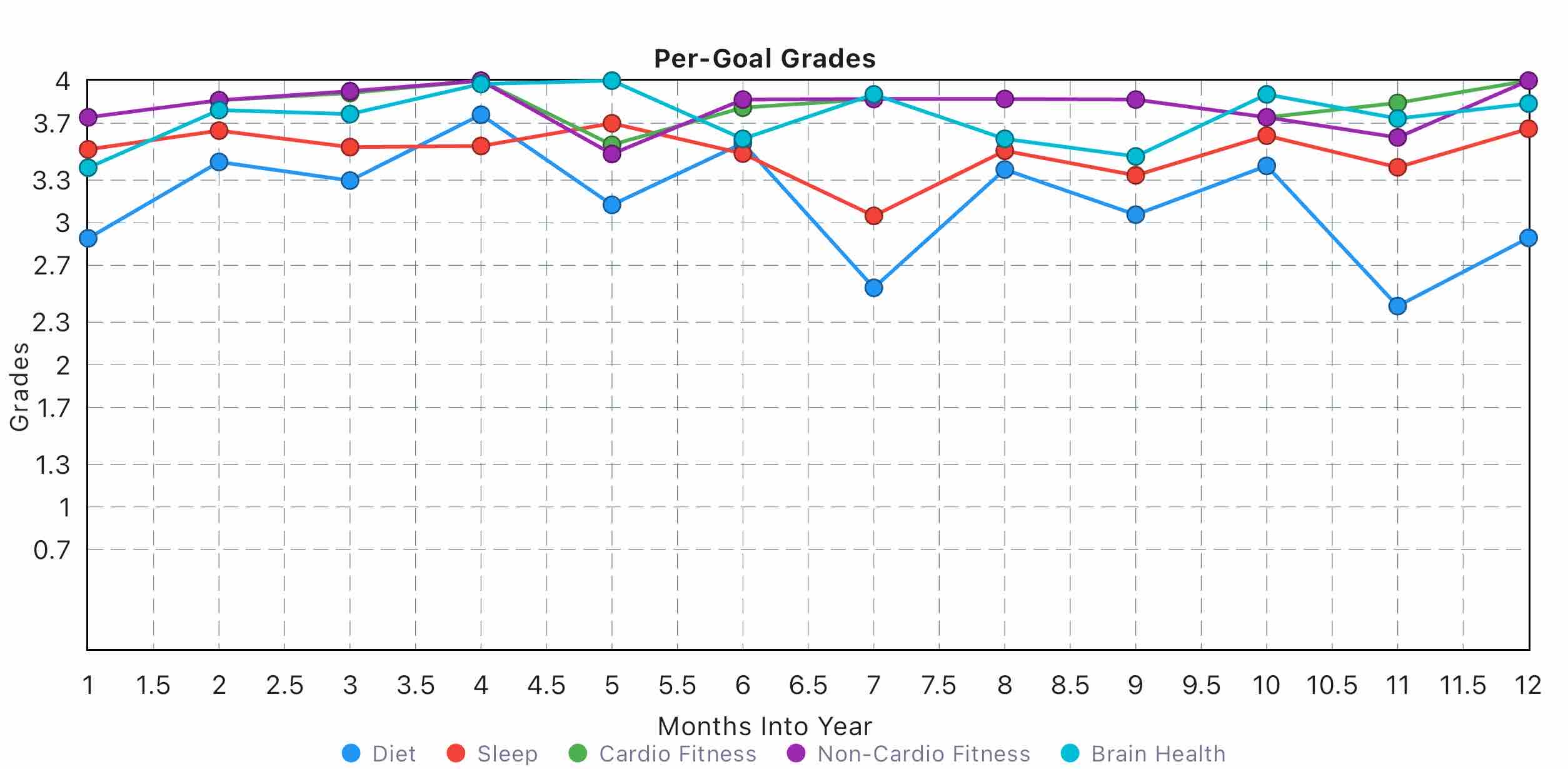
Figure 1: Accountability Grades Per Month
My grades per month have never been consistent for a full year until 2024. My concerns about shifting to having free days never materialized. In fact the lowest grade I ever had in the workouts was the last month I was doing the old plan. Is it perhaps “cheating” a bit since before I’d have to find an hour each and every day to get some exercise in? Sure that’s one way to look at it. But the volume of working out I’m averaging per day is still more than an hour even with the rest days due to the training load being harder on training days. From a life-long perspective, which is what we are really driving at with these grades, it is as good or better. So getting an A grade for doing nothing on a free day is as legit as not getting bonus grades for exercising for 3+ hours on a long run day. I was also able to keep the mental exercises locked in pretty well too. Sleep was a solid grade that had some rough spots I could work on improving a bit. Diet is the thing that suffered the most, especially in July, November, and December. July’s low number was driven by a vacation full of the usual junk eating. November was driven by over indulgence in eating through Halloween candy. December’s was driven a bit by holiday eating but also having to eat more of the left over Halloween junk food and junk food for carb loading. Even these low grades were still in the middle of the C-range. So while not great they weren’t horrible. Over the year span it was still an improvement over 2023 which was very solid compared to previous years.
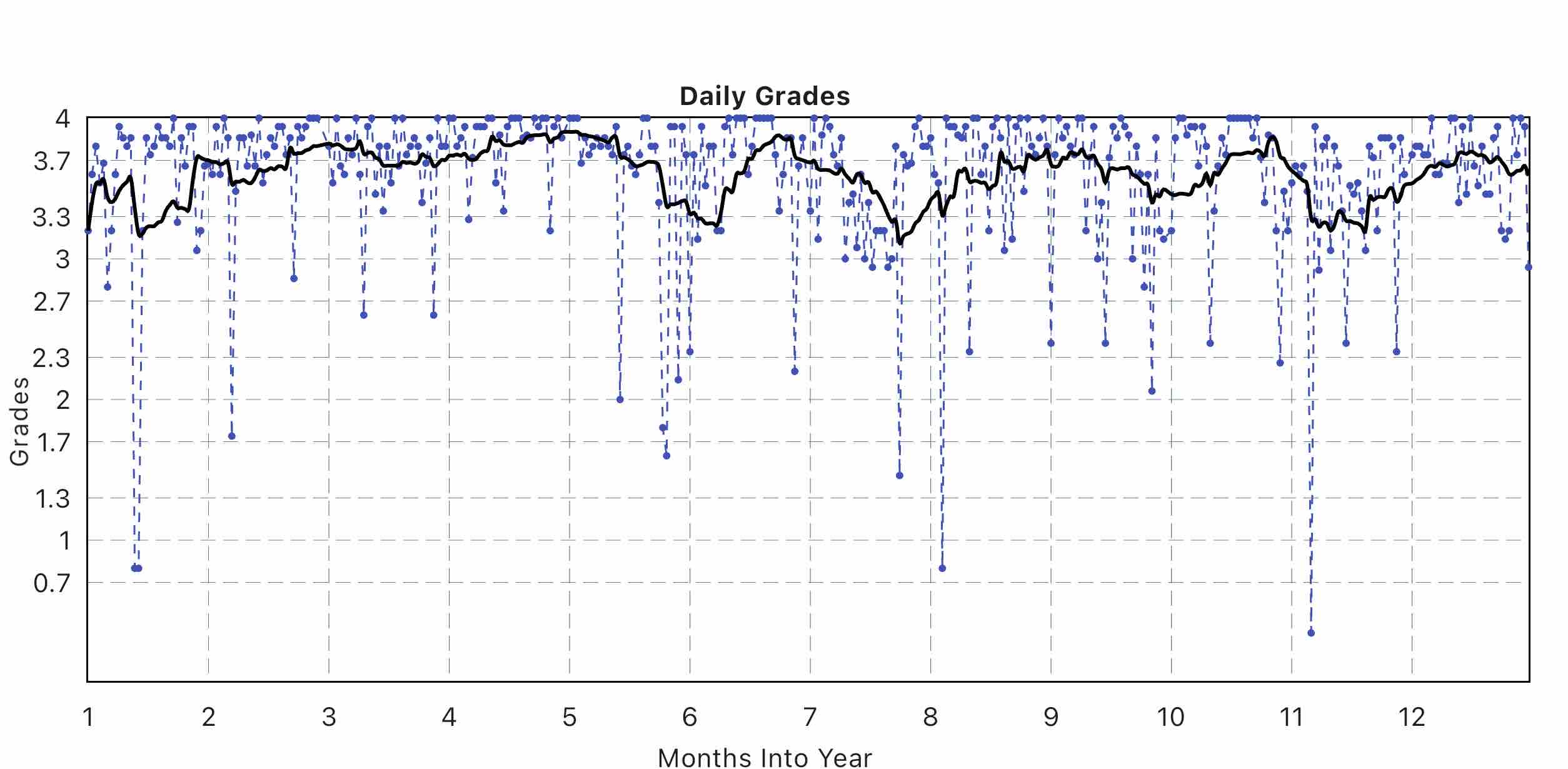
Figure 2: Daily Goal Aggregated Grades
The story looking at the aggregated grade is even more compelling. Last year I stated that the moving average of the daily grade curve spent more time than any other year yet above 3.0. I’m never looking for perfection. I’m looking for good enough. The grades are designed so that B or better should be good enough for maintaining a good long healthspan to take me into old age. Staying there for the better part of a year is a minimally sufficient goal. Staying above the 3.0 line the whole year is ideal though. 2024 was the first year that I was able to achive that exact state. In fact most of the year we were in the B+ range and several months were even A-. That was through vacations, birthdays, days I just felt like cutting loose on diet, perturbations to sleep schedules. You know, real world things that happen to people. You can see plenty of days where I scored very low, the lowest being on November 6th where I got an F on every category except diet where I scored a mere C-. But overall the performance held over the entire year, and it shows in the final grades:
| 2024 | 2023 | 2022 | 2021 | 2020 | |
|---|---|---|---|---|---|
| Goal 1 (Diet) | 3.15 (B) | 2.47 (C+) | 2.43 (C+) | 2.44 (C+) | 2.49 (C+) |
| Goal 2 (Sleep) | 3.50 (B+) | 3.42 (B+) | 3.50 (B+) | 3.65 (B+) | 3.75 (A-) |
| Goal 3 (Cardio Fitness) | 3.84 (A-) | 3.34 (B+) | 2.54 (C+) | 2.98 (B-) | 2.95 (B-) |
| Goal 4 (Non-Cardio Fitness) | 3.82 (A-) | 2.55 (C+) | 1.68 (D+) | 1.41 (D+) | 2.13 (C) |
| Goal 5 (Brain Health) | 3.75 (A-) | 2.48 (C+) | 2.31 (C+) | 2.91 (B-) | 2.19 (C) |
| Total GPA | 3.61 (B+) | 2.85 (B-) | 2.49 (C+) | 2.68 (C+) | 2.70 (B-) |
Last year’s grades were all good news. This year’s grades are even better news than that. Sleep was the one score that I faltered compared to previous years, but it still ended with a 3.5 (B+). Having good sleep is indispensible so I do need to try to dial that up a bit but a 3.5 is still a pretty solid score. Diet was the weakest of all of the scores but it was still a 3.15, which is a solid B. It also happens to be highest grade I’ve ever gotten on the diet score by a full 0.1 points, 2018’s 3.05. The three exercise goals were all hit out of the park: cardio, non-cardio, and brain health. The execution of the cardio and non-cardio were near perfect scores with 3.84 (A-) and 3.82 (A-), respectively. The brain health exercises I was a bit sloppier with. In all honesty in many cases I was hitting the letter of the score but not the spirit of it. That’s enough to get a decent grade but still miss the point a bit. Still that was as olid 3.75 (A-). For these three grades I never had anything remotely approaching these grades. That also made the overall GPA of 3.61 (B+) the highest grade I ever achieved for a year. 2023 took that crown previously but this score dusted it. With a bit more refinement on diet or sleep I could see a path to achieving an A- for the overall GPA. Beyond the grades the proof of my strong performance is in the nutrition and biometric data too.
Nutrition
Building on last year’s greatly improved nutritional performance, having things dialed in the full year also helped see even more improvements on the nutrition front:
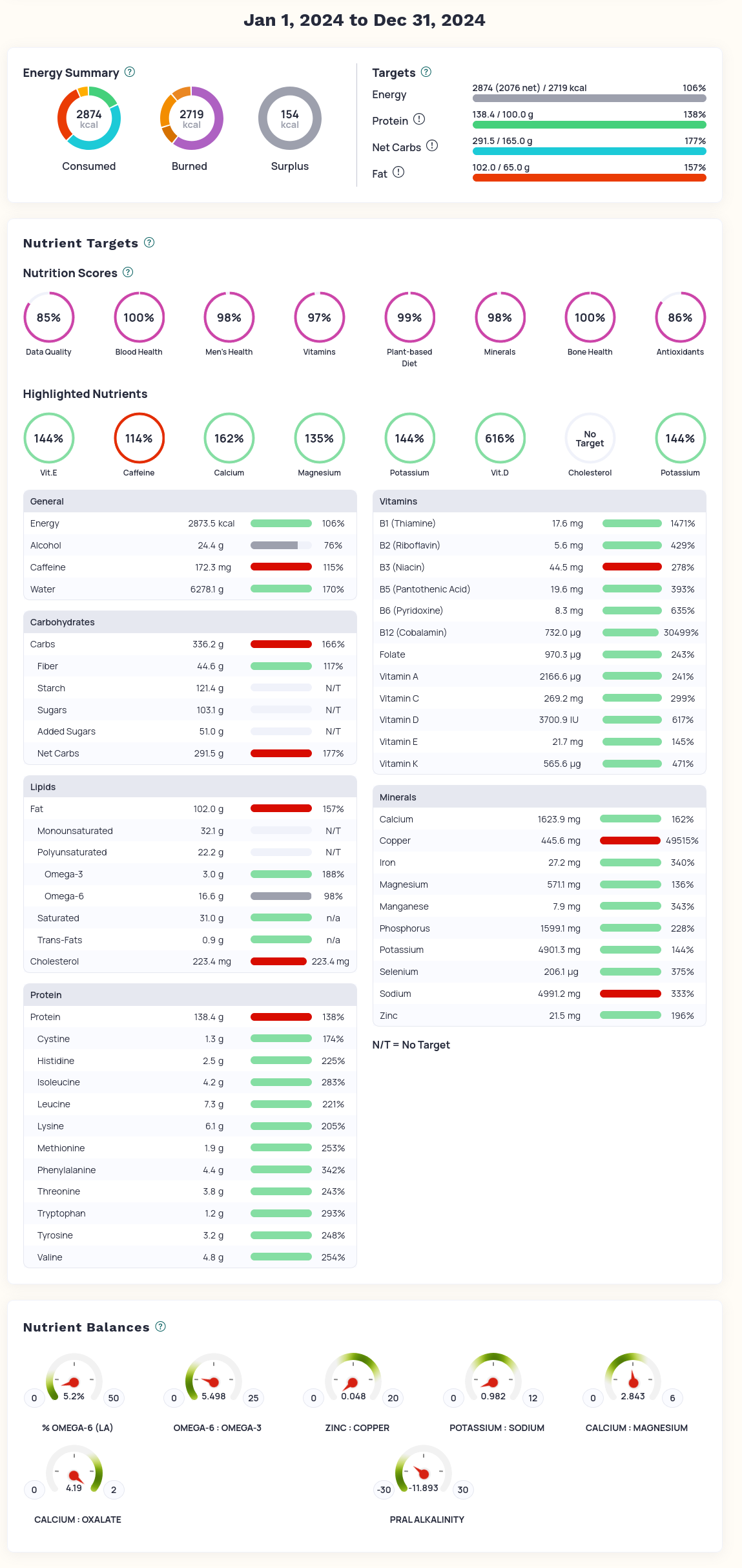
Figure 3: Annual Daily Average Nutrition
I’m going to start with the more negative points first since there is only one: sodium consumption which was already high went up even higher. Doing a lot of running in high heat probably mitigates this to some extent. For the longer runs I’m even intentionally consuming salt-fortified gummies/gels/etc. But it’s not like that is all the increase. A lot of the increase came from swapping in things like Daring Chicken and my morning high protein breakfast cereal apparently having more sodium than I thought. As long as blood pressure stays in bounds, see next sections, I won’t be as worried about it but I do want ot get it down. One bright spot on this front is that the Potassium-Sodium ratio improved despite the increased sodium consumption. This ratio is a big factor in the blood pressure regulation story for me. So I need to work on getting the sodium consumption lower but things aren’t in too horrible a state so far.
The next category of things are things that are not so bad. In each of these categories things have improved:
- Caffeine levels are just above the 150 mg a day average I shoot for but they were ever so sligthly lower.
- Cholesterol consumption is just over the RDA but I’m striving for half of the RDA. Still it is a drop from 345.9 to 223.4. That is a big improvement that I hope to build on.
- Calories consumed were way higher than last year but so was my calorie burn. The calories consumed did sligthly outgrow the calories burned however so that did lead in the end to a slight gain in body fat. But even that stayed within a decent range.
Everything else is great, which again is a big improvement from last year’s already important improvements:
- I got the minimum RDA/DV on every nutrient. Even without supplementation the only two that I may have missed the mark ever so slightly, (Vitamin D and E), were closer to 100% of RDA than they were in 2024. With supplementation it’s not even close.
- I got fiber consumption over 100% of RDA for the first time. The closest I came to that was 2018 hitting fiber exactly.
- Alcohol consumption was just under the 2 drink per day average maximum value I target. It works out to be like 8 ounces of wine or 21 ounces of beer.
- Fatty acid ratios are looking good
- The alkanity score which was already the best ever last year was dramatically improvement over that this year. I’m using this metric to crudely estimate how fruit/veggie heavy as a proportion of calories my diet is see this explainer .
Overall there is a lot in this performance I can be proud of and look to at least maintain momentum if not improve upon into 2025.
Body Composition
I started off the year with a bit of a rebound in body fat compared to the lows from the summer time. But those highs were still dramatically lighter and leaner than they were at the beginning of 2024. For 2025 we start with a bit of a similar story.
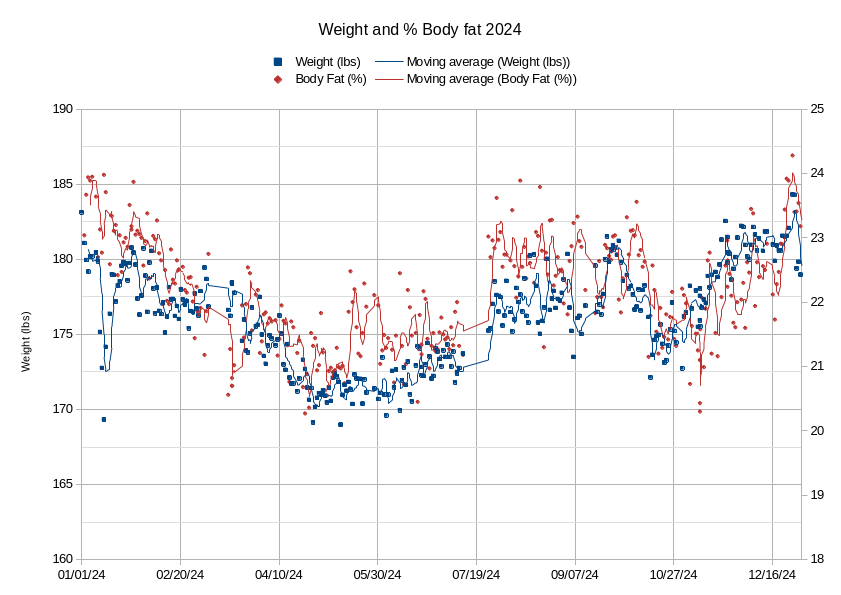
Figure 4: Annual Body Fat and Weight History
I was able to get leaned out to what I consider to be my ideal body fat percentage for longevity. I even held it for the first half of the year. But the second half of the year I let off the gas a bit on diet. The ramping up in exercise helped offset to some extent. The vacation in July was the first big bump up. I middled around with the elevated body fat for August and September. If anything maybe even trending up. October I was able to get things more locked in and back down to the top of the ideal level again just like I had before the July vacation. November and December though was a caloric gorge fest. I can’t blame eating to compensate for training because a substantial percentage of those extra calories were in the candy category. The trends in body weight and body fat growth match the net calories for that time period:
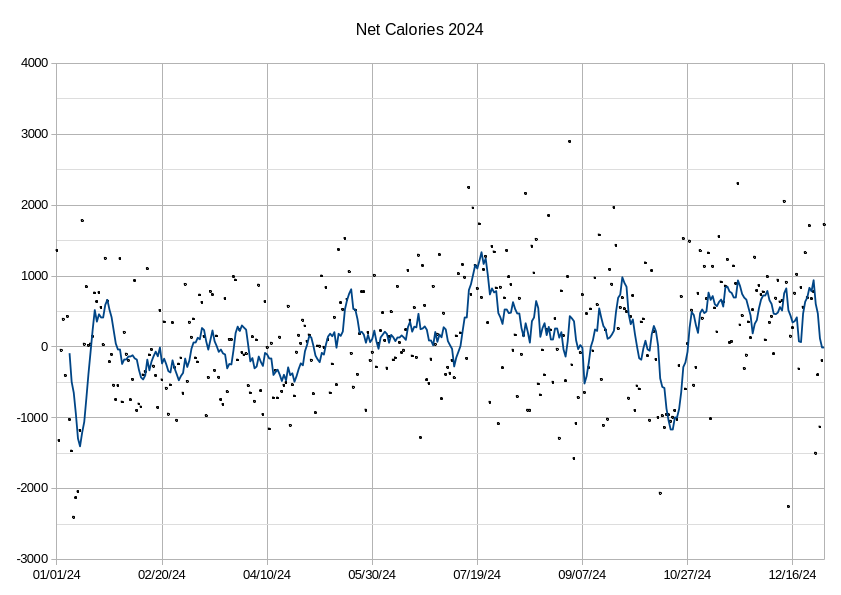
Figure 5: Annual Net Calories History
There was a bit of a period during the end of the marathon training where weight kept going up but body fat stayed relatively flat. Body fat is what I care about more than weight. That’s why I prefer to call it “leaning out” than “losing weight”. But in the end, things eventually snapped back into alignment and the trends on weight and body fat caught up by the end of the year. The overall trend then had me slightly leaner but heavier at the end of the year than at the beginning but essentially it was a bit of a wash. These levels of body fat are slightly above the top of my ideal range but we are talking about the difference of a couple pounds of body fat to get back into the top of that range.
How do I determine my “ideal body composition” zone? I started getting DEXA scans, the gold standard of body composition technology, in the middle of 2023. These bio-impedenec scales and calipers only get you so far. There are ideal body composition charts that provide some good guidance. But a big part of the issue with fat is with the visceral fat around our organs. Excess visceral fat correlates with prevalence of diseases like diabetes. I figured as long as my overall body fat and visceral fat levels were in the right zone then I’d be good to go. It turned out I had about a pound of visceral fat to lose. That would require a little more leaning out than I had by the beginning of 2024. I got down to my leanest in the May time frame but by the time I got the second DEXA scan done in early July things had bounced up slightly. Even at those slightly elevated levels I still was well within the target range for visceral fat. That’s why I’ve been targeting an upper limit of 22% as measured by the scale on body fat. I put the scale caveat in because the number from the scale is 2-3 points off of what the actual body fat measured by DEXA scan is. It still is helpful for long term trend capture, in case looking in the mirror or feeling around couldn’t tell me where I am anyway. While it is certainly possible for me to maintain great health being even leaner by several percentage points of body fat I don’t feel the need to try that at this time. For me, right now, I think shooting for this 19-20% body fat realm is what will work best for me.
Biometrics
I had hoped to have more progress on being able to do biometric trend graphs but that’ll have to wait another year. The overall trends in all of those were neutral to positive however. VO2Max had some up and down but it ended the year higher than the year began. Heart Rate Variability saw similar oscillations around good levels for me and also ended the year slightly better than it started. Resting Heart Rate (RHR) was also in a good level the whole year, oscillating as well, but again showing improvement over all. There was a five point jump from COVID in May, from 44/45 to 49/50, as well as a comparable one in November from the increased training and/or weight gain. But these are well within normal levels for me. Blood pressure, the one I do have a chart for overall looked good for the year except for a spike during my fast in January and a blip around early November.
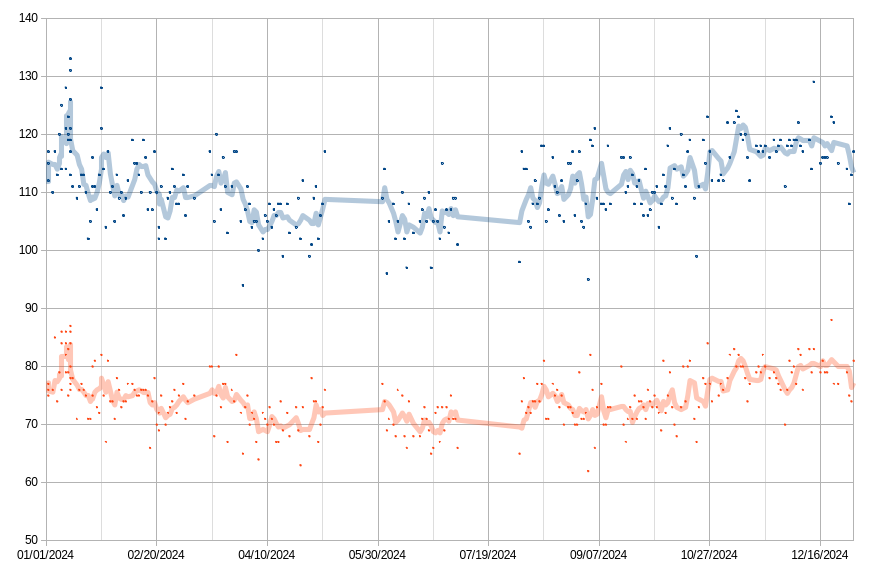
Figure 6: Blood Pressure History
I will admit that although the average curves for blood pressure are still staying at or below 120/80 by the end of the year I preferred them when they were more like 105/70 mid-year. Talking about it with my doctor we both see correlation with the weight gain I had over that period of time. A confounding factor is that the Potassium/Sodium ratios were also not as dialed in over that time. It seems that dialing in both of these is the secret to get me off of the 120/80 upper boundary for blood pressure. So that should mean dialing in my sodium consumption more and getting these extra couple pounds of fat off my frame sooner rather than later.
Looking forward to 2025
2025 was my first banner year. Did I ace every category? No. But I had very solid performances in every one and aced three. I did far better than I have any other year of the past seven I’ve been tracking it. That has me with even more momentum coming out of 2024 than I had going into it.
The goals are really well dialed into the areas they need to be at this point. So from a letter of the goals they will remain the same:
- Goal 1 (Diet): Eat a plant dominant Mediterranean diet averaging at least 100 grams of protein a day, a stretch goal of over 120 grams of protein
- Goal 2 (Sleep): Get 7-8 hours of sleep a night
- Goal 3 (Cardio Health): Meet training plan goals set by coach
- Goal 4 (Non-Cardio Health): Meet training plan goals set by coach
- Goal 5 (Brain Health): 15-20 minutes of meditation or alternative learning, stretch goal of 15-20 minutes of meditation and alternative learning or a second meditation session.
The goal I need to make the most improvement on is diet. As I often write, I will never feel bad about having indulgent food habits if it matters: special events, a special food location, a vacation, et cetera. But a lot of the slop in the diet grade was mindless eating of junk food unnecessarily at home. If I had just thrown away excess Halloween candy it would have made a substantial difference in my end of year diet, body composition, and blood pressure. That’s just a fact. So the types of tweaks I need to make aren’t huge. It’s mostly trying to eat more dialed and avoiding the junk food at home. The next goal that needs a little more attention is the brain health exercises. I’m getting the time in but I’ve been doing them half-assed for too long. I need to be a bit more focused on that. Lastly, I could stand to get a little bit better on sleep as well. On the exercise front things are firing on all cylinders. My coach and I have had some good conversations about what we want to achieve this year. I’m very much looking forward to keeping that momentum up.
While I am highlighting things to improve I do believe that if I turned in this year’s performance every year I’d probably be doing better than I need to for my longevity/healthspan goals. With some small tweaks they could just build in even more margin. It’ll never be perfect and I never need it to be. As I stated previously, I’m not going to let perfect be the enemy of good enough.




 2025-01-01
in
2025-01-01
in

 18 min read
18 min read